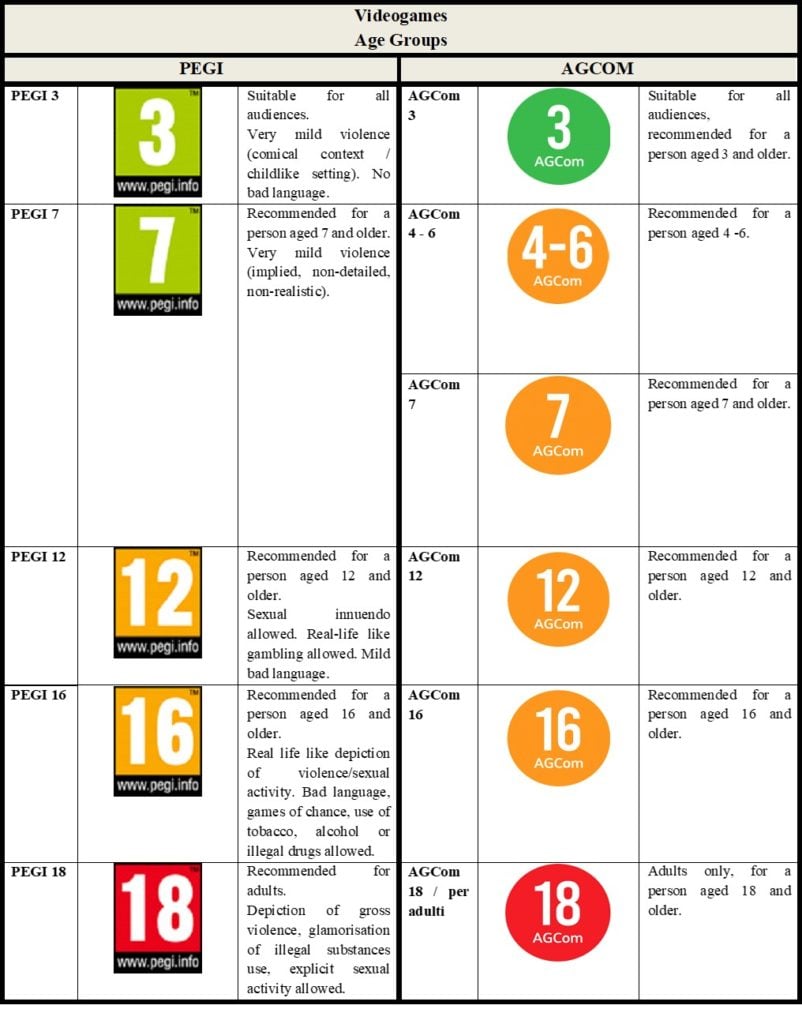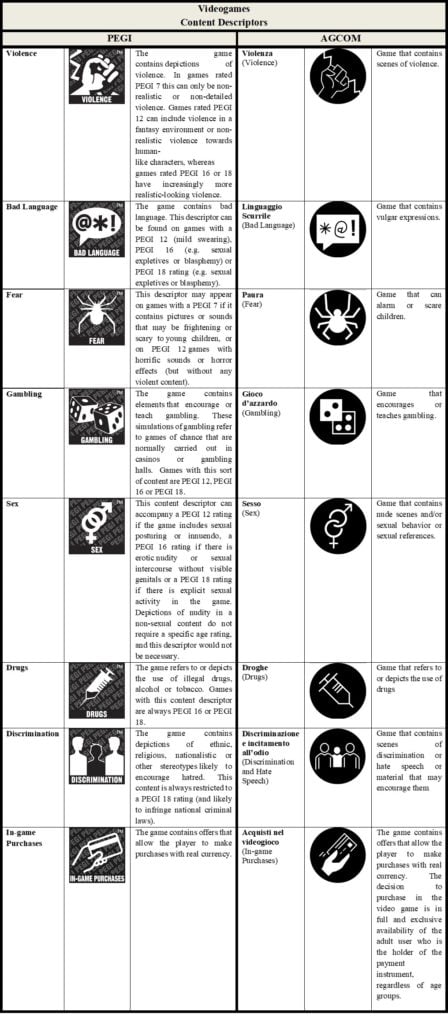Introduction
What is content rating? Rating entertainment content means giving information on its suitability for its audience. The way in which such information is presented to, and evaluated by, the public is traditionally the primary objective of self-regulation. Drawing from the best practices of the industry, this serves the purpose of protecting minors from harmful content by enabling them (and their legal guardians) to make informed choices.
One of the best examples of such self-regulated systems is the Pan-European Game Information (“PEGI”) system, developed and launched in 2003 by the Interactive Software Federation of Europe (“ISFE”), an independent organization that represents the videogame industry at European level, which is now voluntarily used in 39 countries (including Israel).
Italy is now one of the few countries to have its own official content rating system in place. On 6 March 2019, the Italian Communications Regulatory Authority (Autorità per le Garanzie nelle Comunicazioni – “AGCOM”) issued its Resolution no. 74/19/CONS, concerning the “Regulation on the rating of audiovisual works intended for the web and videogames as per art. 10 of Legislative Decree no. 203 of 7 December 2017” (“Regulation”), which entered into force on 13 April 2019. All Affected Providers (as defined below) are now required to ensure that the Affected Works (as defined below) made available to the public are rated according to the provisions of this Regulation.
In particular, the Regulation generally establishes a rating system for each category of Affected Works, composed of symbols (or pictograms) based on age groups (“Age Ratings”, i.e. content is labelled with a minimum age recommendation) accompanied by other specific symbols (“Content Descriptors”, i.e. labels informing on sensitive content such as violence or sex). The Regulation’s provisions are further implemented by the rules set out in specific guidelines adopted with Resolution no. 359/19/CONS of 18 July 2019, published on 1 August 2019 and entered into force on 2 August 2019 (“Guidelines”,). These establish a permanent Observatory within AGCOM, which will not only monitor the implementation of the rating system, but will also elaborate shared approaches to identify and address the evolving issues of the sector.
The entry into force of the Regulation triggers the non-compliance of any other rating system, despite the merits of the system itself, thus exposing the relevant provider to the risk of sanctions. Failure to comply with the Regulation’s provisions in this regard may result in the application of administrative sanctions ranging from EUR 25,000 to EUR 350,000 and, in the most serious cases, suspension of any previously granted concession or authorization.
Furthermore, specific sections of the Regulation (Clause 3.4) and the Guidelines (Part III) address the initiatives desired by AGCOM, with the collaboration of the institutions and the Affected Providers, in relation to the implementation of the activities to raise awareness and promote media and digital literacy.
Scope of the Regulation
For the purposes of the Regulation, Affected Providers are the “Audiovisual Media Service Providers by other means”, as defined in AGCOM Regulation 606/10/CONS[1] and the “Hosting Service Providers”, as defined by article 16 of Legislative Decree no. 70/2003[2]. Affected Works, on the other hand, are “Audiovisual Works Intended for the Web[3]” and Videogames[4].
As to the territorial scope of the Regulation, any videogame made available on a platform and reachable by Italian consumers may be considered as being subject to the Regulation, regardless of the platform’s country of origin or of the Affected Provider provider’s place of incorporation.
This because the Regulation follows the attempts of EU regulators – Italy included – to make online platforms and providers accountable for the hosted content. In the context of these attempts, Italian regulators have expressly derogated the country of origin principle in the past, for example with respect to copyright infringing activities and, of course, in any case consumer rights are involved.
Obligations for the Affected Providers
The obligations of Affected Providers (and, in specific cases, on other individuals), as set out in the Regulation and further specified in the Guidelines, differ in type and scope depending on the category to which the Affected Works belong.
For all Affected Works, rating obligations prohibit making the relevant content available on electronic communications networks or services without the rating set out in the Regulation (Clause 3.2).
The regulatory framework also provides for certain specificities.
Videogames in particular must also display the applicable rating on physical products, digital products, and in the advertising and online sale of the Affected Works (Clause 17). Furthermore, there are specific obligations as to the labelling and advertising of these works. Affected Providers of Audiovisual Works Intended for the Web are further required to adopt and maintain certain technical measures (“Parental Control Tools”) that are capable of restricting or inhibiting the use of content according to its rating. Surprisingly, a corresponding obligation is not provided for videogames.
Videogames
Rating provisions
The Regulation identifies two different rating systems that may be applied to videogames. Affected Providers may choose between the AGCOM system, which is based on a self-assessment carried out by the responsible party, or the PEGI system, the latter being considered equivalent to the former according to the following equivalence criteria[1]:
- Videogames which are already subject to the PEGI rating procedure and that are already distributed on the market are considered compliant with the Regulation, without further obligations for the Affected Providers;
- Affected Providers of videogames and related DLC intended to enter the Italian market any time after the entry into force of the Guidelines must ensure that the products are already subject to the PEGI rating procedure, or apply the AGCOM system at the time of release on the Italian market; and
- In any case, the parties of a licensing agreement are free to establish which party (i.e. the content provider or the hosting provider) is responsible for the rating.
Displaying and advertising provisions
According to the Regulation, the applicable Age Ratings and Content Descriptors must be displayed on physical products, digital products, and in the advertising and online sale of videogames (Clause 17).
With exclusive reference to online distribution, the Guidelines further require the display of the applicable Age Ratings and Content Descriptors on the product pages of the storefront, or any other web page or distribution platform that allows the purchase, execution, download of or access to the product (Part II, par. 3.a.). Displaying of the pictograms under the AGCOM system must be carried out in accordance with the provisions of the Guidelines and any advertising activity must also comply (with the necessary adjustments) with the last version of the PEGI Labelling and Advertising Guidelines, setting the appearance, size and position requirements of the pictograms.
Comparative overview of PEGI and AGCOM rating systems for Videogames


Functions of the Permanent Observatory
The Technical Board in charge of drafting the Guidelines has evolved into a permanent Observatory where any Affected Provider and other interested parties (such as audiovisual content and videogame producers and publishers, academic institutions, and related stakeholders) may participate to share their views and contribute to the ongoing discussions on content rating.
In particular, the Observatory will[1]:
- constitute a stable place of dialogue between AGCOM, the institutions and the operators that will be in charge of dealing with the issues related to the practical application of the rating activities, to the assessment of the topicality of the persistent adequacy of the provisions contained in the Guidelines, and to the monitoring of the evolution of the sector;
- elaborate shared approaches, provide any proposals for the update of the Guidelines (which shall take place every three years, as per Clause 14 of the Regulation) and support the fulfilment of the same with regard to the activities of rating, promotion and awareness to the conscious use of contents; and
- guarantee the technical contribution of AGCOM at the EU level on the specific subject of rating.
Baker McKenzie will join in the works and meetings of the Observatory.
Open issues and future challenges
While this new regulation is a significant step towards a more modern approach to the protection of minors in video gaming and audiovisual spaces, its actual implementation will undoubtedly be challenged by equally modern issues.
Firstly, the Regulation does not provide full clarity as to the subjective scope of its provisions. Indeed, it does not take content providers into account, and the scope of the Affected Providers is so broad that it could easily include any digital distribution provider. In this sense, when operating any app store, the relevant provider may qualify as a Hosting Service Provider under the meaning of the Regulation because it would host third party contents through the store — including videogames — that would be then made available to the public.
Secondly, the Regulation does not seem to address platform apps, i.e. those apps allowing interaction with multiple content. While PEGI rules contain specific provisions in this regard with reference to boxed games distributed in brick-and-mortar stores, even in that system there is no equivalent provision for online distribution of multi-titles. The problem with enabling the public to access multiple products lies in the very rationale under content rating systems: a clear information on the content. Such information could be incomplete or inaccurate in case of multiple, diverse content that needs to be addressed separately.
Given the lack of these provisions, what is the best option for the Affected Providers? May they apply an overall rating? A general age rating may not be comprehensive of the diverse content to which the platform gives access. Maybe, in the absence of a specific catch-all label (e.g. the “Parental Guidance Recommended” for the PEGI system), the highest age should be indicated. In case of multi-title products, if the platform app gives access to even a single product intended for use by – say – a person aged 16 or older, the label PEGI 16 or AGCOM 16 should be used to rate the app. This is because, unless the platform provides parental control / age verification tools, the user could have access through the platform to all content, including those intended for people aged 16 or older.
The Regulation will certainly and deeply influence the video gaming industry, and to this end it will be essential to look closely at the works of the Observatory, which will have the challenging task of shredding the shadows of the Regulation while embracing the legitimate needs and prerogatives of the industry.
[1] Linear or non-linear AVMS providers, operating on electronic communication networks other than those via coaxial cable, satellite and terrestrial, e.g. the Internet network, including broadband, and mobile networks, excluding transmissions via DVBH, that: (i) bear the editorial responsibility for the choice and the content of the AVMS; and (ii) determine the manner in which the content is organised; and (iii) whose annual revenues from advertising, teleshopping, sponsorships, contracts and agreements with public and private entities, public grants and pay-TV offers exceed 100,000 euros.
[2] The Information Society Service Providers consisting in the storage of information provided by a recipient of the service.
[3] Defined by the Regulation as the audiovisual works primarily intended for distribution on electronic communications networks or services. The Guidelines further specify the scope of this definition.
[4] Defined by the Regulation as the interactive multimedia works of a videogaming nature that can be exploited by any means of communication that allow their operation.
[5] See Guidelines, Part II, par. 2.
[6] See Annex B to the Guidelines.



